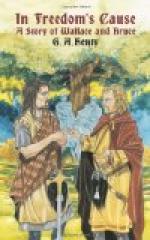The road by which the English would advance was the old Roman causeway running nearly north and south. The Bannock Burn was fordable from a spot near the Park Mill down to the village of Bannockburn. Above, the banks were too high and steep to be passed; while below, where ran the Bannock through the carse, the swamps prevented passage. The army was therefore drawn up, with its left resting on the sharp angle of the burn above the Park Mill, and extended where the villages of Easterton, Borestine, and Braehead now stand to the spot where the road crosses the river at the village of Bannockburn. In its front, between it and the river, were two bogs, known as Halberts Bog and Milton Bog, while, where unprotected by these bogs, the whole ground was studded with deep pits; in these stakes were inserted, and they were then covered with branches and grass. Randolph’s centre was at Borestine, Bruce’s reserve a little behind, and the rock in which his flagstaff was placed during the battle is still to be seen. To Randolph, in addition to his command of the centre division, was committed the trust of preventing any body of English from passing along at the edge of the carse, and so making round to the relief of Stirling.
On the morning of Sunday, the 23d of June, immediately after sunrise, the Scotch attended mass, and confessed as men who had devoted themselves to death. The king, having surveyed the field, caused a proclamation to be made that whosoever felt himself unequal to take part in the battle was at liberty to withdraw. Then, knowing from his scouts that the enemy had passed the night at Falkirk, six or seven miles off, he sent out Sir James Douglas and Sir Robert Keith with a party of horsemen to reconnoitre the advance.
The knights had not gone far when they saw the great army advancing, with the sun shining bright on innumerable standards and pennons, and glistening from lance head, spear, and armour. So grand and terrible was the appearance of the army that upon receiving the report of Douglas and Keith the king thought it prudent to conceal its full extent, and caused it to be bruited abroad that the enemy, although numerous, was approaching in a disorderly manner.
The experienced generals of King Edward now determined upon making an attempt to relieve Stirling Castle without fighting a pitched battle upon ground chosen by the enemy. Had this attempt been successful, the great army, instead of being obliged to cross a rapid stream and attack an enemy posted behind morasses, would have been free to operate as it chose, to have advanced against the strongholds which had been captured by the Scots, and to force Bruce to give battle upon ground of their choosing. Lord Clifford was therefore despatched with 800 picked men-at-arms to cross the Bannock beyond the left wing of the Scottish army, to make their way across the carse, and so to reach Stirling. The ground was, indeed, impassable for a large army; but the troops took with them faggots and beams, by which they could make a passage across the deeper parts of the swamp and bridge the little streams which meandered through it.




